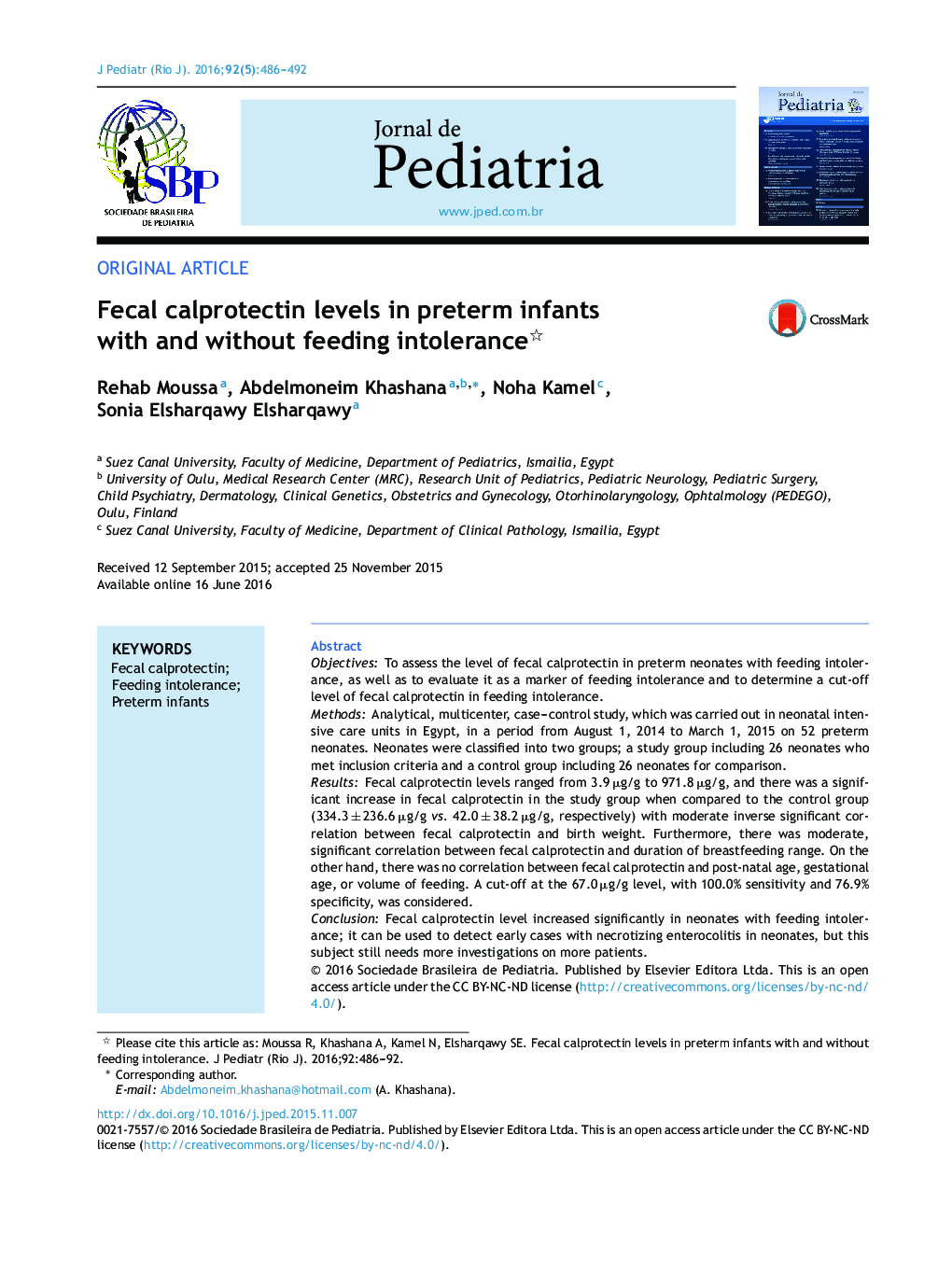| کد مقاله | کد نشریه | سال انتشار | مقاله انگلیسی | نسخه تمام متن |
|---|---|---|---|---|
| 4153754 | 1607064 | 2016 | 7 صفحه PDF | دانلود رایگان |
ObjectivesTo assess the level of fecal calprotectin in preterm neonates with feeding intolerance, as well as to evaluate it as a marker of feeding intolerance and to determine a cut-off level of fecal calprotectin in feeding intolerance.MethodsAnalytical, multicenter, case–control study, which was carried out in neonatal intensive care units in Egypt, in a period from August 1, 2014 to March 1, 2015 on 52 preterm neonates. Neonates were classified into two groups; a study group including 26 neonates who met inclusion criteria and a control group including 26 neonates for comparison.ResultsFecal calprotectin levels ranged from 3.9 μg/g to 971.8 μg/g, and there was a significant increase in fecal calprotectin in the study group when compared to the control group (334.3 ± 236.6 μg/g vs. 42.0 ± 38.2 μg/g, respectively) with moderate inverse significant correlation between fecal calprotectin and birth weight. Furthermore, there was moderate, significant correlation between fecal calprotectin and duration of breastfeeding range. On the other hand, there was no correlation between fecal calprotectin and post-natal age, gestational age, or volume of feeding. A cut-off at the 67.0 μg/g level, with 100.0% sensitivity and 76.9% specificity, was considered.ConclusionFecal calprotectin level increased significantly in neonates with feeding intolerance; it can be used to detect early cases with necrotizing enterocolitis in neonates, but this subject still needs more investigations on more patients.
ResumoObjetivosAvaliar o nível de calprotectina fecal em neonatos prematuros com intolerância alimentar, além de avaliá-lo como um indicador de intolerância alimentar e determinar um nível de corte da calprotectina fecal na intolerância alimentar.MétodosEstudo caso-controle analítico, realizado em um multicentro de unidades de terapia intensiva neonatais no Egito, no período de 1° de agosto de 2014 a 1° de março de 2015, com 52 neonatos prematuros. Os neonatos foram classificados em dois grupos; um grupo de estudo incluindo 26 neonatos que atenderam aos critérios de inclusão e um grupo de controle incluindo 26 neonatos para comparação.ResultadosOs níveis de calprotectina fecal variaram de 3,9 μg/g a 971,8 μg/g e houve um aumento significativo da calprotectina fecal no grupo de estudo quando comparado ao grupo de controle (334,3 ± 236,6 μg/g em comparação a 42,0 ± 38,2 μg/g, respectivamente) com correlação inversa, moderada significativa entre a calprotectina fecal e o peso ao nascer. Adicionalmente, houve correlação moderada significativa entre a calprotectina fecal e a duração do intervalo de amamentação. Por outro lado, não houve correlação entre a calprotectina fecal e a idade pós-natal, a idade gestacional ou o volume de amamentação. Foi considerado um corte nos níveis de 67,0 μg/g; com sensibilidade de 100,0% e especificidade de 76,9%.ConclusãoO nível de calprotectina fecal aumentou significativamente em neonatos com intolerância alimentar e podemos utilizá-lo para detectar casos precoces com enterocolite necrosante em neonatos, porém ainda são necessárias mais investigações em mais pacientes.’
Journal: Jornal de Pediatria - Volume 92, Issue 5, September–October 2016, Pages 486–492
